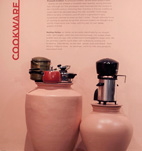This is our story, as everyday cookware, ubiquitous to the Indian kitchen.
KADHAI AND TAVA: A Kadhai is a wok-like utensil used for preparing curries and deep-frying whereas a tava is a skillet that cooks flatbreads. Traditionally, both our forms were crafted from cast iron because the metal’s conduction of heat is slow, making it perfect for long-simmering recipes and slightly brownedrotis. Our material form is also good because it boosts the food’s iron content substantially. Recent innovations in our forms in Teflon-coated materialthat is non-stick and tends to use less oil, is gaining popularity across Indian kitchens.
PRESSURE COOKERS: As pressure cookers, we are muchloved in India because we cam prepare a complete meal speedily, saving time and fuel. Although our first prototypes were imported into the country in the mid-20th century (following their invention in France),traditional cooks had to be educated about this new ‘scientific’ technology. Effortsby early companies paid off and in a generation’s time, housewives continue to swear by their ‘cooker’. Though alternate forms of cooking are gaining recognition, pressure cookers are thought of as worthy investments even today, with the year on year steady growth of 9-10%.
NESTING PATILAS: As Patilas we are easily identifiable by our straight walls, right-angled jutted rims and concave bases. Our unique shape enables easy storage, with smallerversionsresting within larger ones. We are generally used for quick tasks such as brewing, boiling and re-heating. Alternatively, we are ideal to cook, store and reheat - from stove to fridge to stove - for perishables such as milk, dairy products and cooked food.




